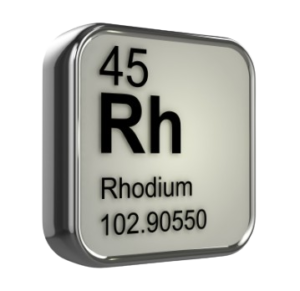 In the world of precious metals investment, few assets have captured the attention of investors quite like rhodium. With its remarkable properties and limited global supply, rhodium has emerged as an increasingly sought-after commodity, offering lucrative opportunities for those looking to diversify their portfolios and capitalize on emerging trends. But for many investors, the question remains: how to invest in rhodium? Join me as we explore the ins and outs of rhodium investment and uncover the strategies for success.
In the world of precious metals investment, few assets have captured the attention of investors quite like rhodium. With its remarkable properties and limited global supply, rhodium has emerged as an increasingly sought-after commodity, offering lucrative opportunities for those looking to diversify their portfolios and capitalize on emerging trends. But for many investors, the question remains: how to invest in rhodium? Join me as we explore the ins and outs of rhodium investment and uncover the strategies for success.
Understanding Rhodium: A Rare and Valuable Metal
Before diving into the specifics of investing, let’s first familiarize ourselves with the allure and significance of rhodium. Rhodium is a rare, silvery-white metal belonging to the platinum group of elements. It is prized for its high reflectivity, corrosion resistance, and catalytic properties, making it indispensable in various industrial applications.
One of the primary uses of rhodium is in catalytic converters, where it helps reduce harmful emissions from vehicles and comply with stringent environmental regulations. Additionally, rhodium is used in the production of jewelry, electronics, and chemical catalysts, further highlighting its versatility and importance in modern industry.
Why Invest in Rhodium?
The appeal of investing in rhodium lies in its scarcity and unique properties, which have made it increasingly valuable in recent years. Unlike gold and silver, which have well-established markets and investment vehicles, rhodium remains relatively niche, offering opportunities for early adopters and forward-thinking investors.
Rhodium prices have surged in recent years, driven by increasing demand from the automotive sector and supply constraints from South Africa, the world’s largest producer of rhodium. This combination of rising demand and limited supply has led to significant price appreciation, making rhodium an attractive option for investors seeking high returns and portfolio diversification.
How to Invest in Rhodium: Strategies and Options
Investing in rhodium requires careful consideration and an understanding of the various strategies and options available. Here are some ways investors can gain exposure to rhodium:
1. Physical Rhodium Bullion
One of the most direct ways to invest in rhodium is by purchasing physical bullion in the form of bars or coins. Rhodium bullion is available in various weights and purities, allowing investors to tailor their investments to their preferences and budget. While acquiring physical rhodium bullion may require significant upfront capital and storage considerations, it provides investors with direct ownership of the metal and a tangible store of value.
2. Rhodium Exchange-Traded Funds (ETFs)
For investors seeking exposure to rhodium without the logistical challenges of storing physical bullion, rhodium exchange-traded funds (ETFs) offer a convenient and cost-effective solution. These specialized ETFs track the price of rhodium and provide investors with diversified exposure to the metal’s price movements. Rhodium ETFs trade on major stock exchanges, providing liquidity and ease of access for investors looking to add rhodium to their portfolios.
3. Precious Metal Mining Stocks
Another way to gain exposure to rhodium is by investing in mining stocks of companies engaged in the exploration, production, and distribution of platinum group metals, including rhodium. By investing in mining stocks, investors can potentially profit from increases in rhodium prices as well as the operational performance and growth prospects of mining companies. However, it’s essential to conduct thorough research and due diligence before investing in individual mining stocks, as the sector can be volatile and subject to various risks.
Risks and Considerations
While investing in rhodium offers the potential for significant returns, it’s essential to be aware of the risks and considerations involved. Rhodium prices can be volatile, driven by factors such as supply disruptions, changes in industrial demand, and market speculation. Additionally, rhodium investment options may have higher fees and less liquidity compared to more established precious metals such as gold and silver.
Investors should carefully assess their risk tolerance, investment objectives, and time horizon before committing capital to rhodium. Diversification is key to managing risk, and rhodium should be considered as part of a well-rounded investment portfolio alongside other asset classes.
Conclusion
In conclusion, investing in rhodium offers an exciting opportunity for investors seeking exposure to a rare and valuable metal with significant growth potential. Whether through physical bullion, ETFs, or mining stocks, investors have a range of options available to gain exposure to rhodium and capitalize on its unique properties and increasing demand.
By understanding the fundamentals of rhodium investment and conducting thorough research, investors can navigate the complexities of the market and position themselves for success. So, for those looking to diversify their portfolios and unlock the potential of precious metals investment, rhodium presents a compelling opportunity to explore.